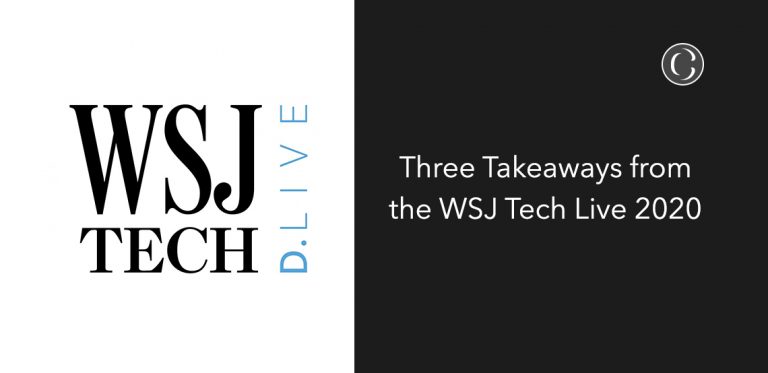Three Takeaways from the WSJ Tech Live 2020

What is the combined role of lawmakers, tech leaders, and privacy experts? How to keep misinformation off the tech platform? How to rebuild trust with gig economy workers?
These are some of the questions discussed at the WSJ Tech Live 2020 – where technology’s biggest headlines are explored, debated, and made. Coruscate served as an unofficial knowledge partner of the event to share their conversation and our recent research.
Here are some of the most important takeaways.
WSJ Tech Live 2020 – Key Takeaways
• The adaptive strategy is key to leverage unexpected event such as pandemic
Each organization has a defined strategy. It undergoes the real test when an unexpected external or internal event hits the organization. While a bare-bones strategy forces you to completely drop it and work on a new one, the adaptive strategy gives you enough time to come up with new use cases based on new market needs.
In an interview with Jason Dean who is the Global Technology Editor at The Wall Street Journal, Aparna Bawa – the COO at Zoom said workplace collaboration was Zoom’s ultimate focus before the pandemic. Once the pandemic hit, the Zoom team became very clear that they were going to be embraced by the world. They were now getting individual users in addition to businesses. They also noticed a rapid change in the overall business environment due to remote work. To address this sudden market change from multiple directions, Zoom had to offer solutions in different use cases that they had never thought before.
Zoom soon identified individual users seeking services for free. Rather than keeping them out of their business operations, Zoom decided to take honor by considering them valuable users, and not free users. With its adaptive strategy, Zoom continued working on its ultimate goal which was workplace collaboration, and addressed new challenges or rather opportunities at the same time without costing much.
As a result, Zoom’s stock price had increased by over 500% during the pandemic!
• Data is just the numbers without sophisticated software and algorithms
Data is beneficial to every business from a barbershop to a unicorn startup unless it is collected, linked, stored, and processed the right way. It describes the problems and shows us the optimal path to find a solution.
In an interview with Stefanie Ilgenfritz who is WSJ Health and Science Coverage Chief, Amy Abernethy – FDP Principal Deputy Commissioner of Food and Drugs said data is easing our fight with coronavirus. In March and April, we did not know much about the virus. But by June and July, we have collected so much real-life data from sources like EHRs, claims databases, Twitter, Reddit, and biosensors that we created a living history of the virus. Data is helping us with finding the pattern of the virus, identifying drug shortage, PPE shortage, patient management, and medication.
But to handle data, it requires sophisticated software and algorithms. And thus, it can never be accomplished by a single entity. Along with academic researchers, new interests such as data visualization companies, companies that offer software for continuous data analysis, and companies that have innovation such as AI-based synthetic data to dodge the data privacy laws should work together with the same goal.
• Personalization fuels sales even during a crisis
In an era when users have multiple options to buy a service or product, you should offer the exact same thing the user is drawing in his mind to turn him into a buyer. From social media platforms to food delivery apps, all are leveraging the personalization technology and it has been working fine for them. However, retail is the industry that needs personalization technology most.
CEO of Stitch Fix which is an online personal styling service valued over $1.6 billion takes personalization to a whole new level. They offer a subscription plan. Every subscriber receives the personalized styling package on a regular basis. You can either keep all of them or return the things which you don’t like.
The magic starts when you buy the subscription plan. It asks you to feed some of the data of your style preferences and measurement. Based on the data you feed and items you keep and return, it learns your styling preferences over time. It later sends this all data to the stylist who stitches the personalized cloth for you with a custom message.
Because of such personalization capabilities, Stitch Fix is able to easily satisfy the ever-changing style preference of users at a very micro level during the pandemic.
Conclusion
“Technology and business are becoming inextricably interwoven. I don’t think anybody can talk meaningfully about one without talking about the other.” – Bill Gates








